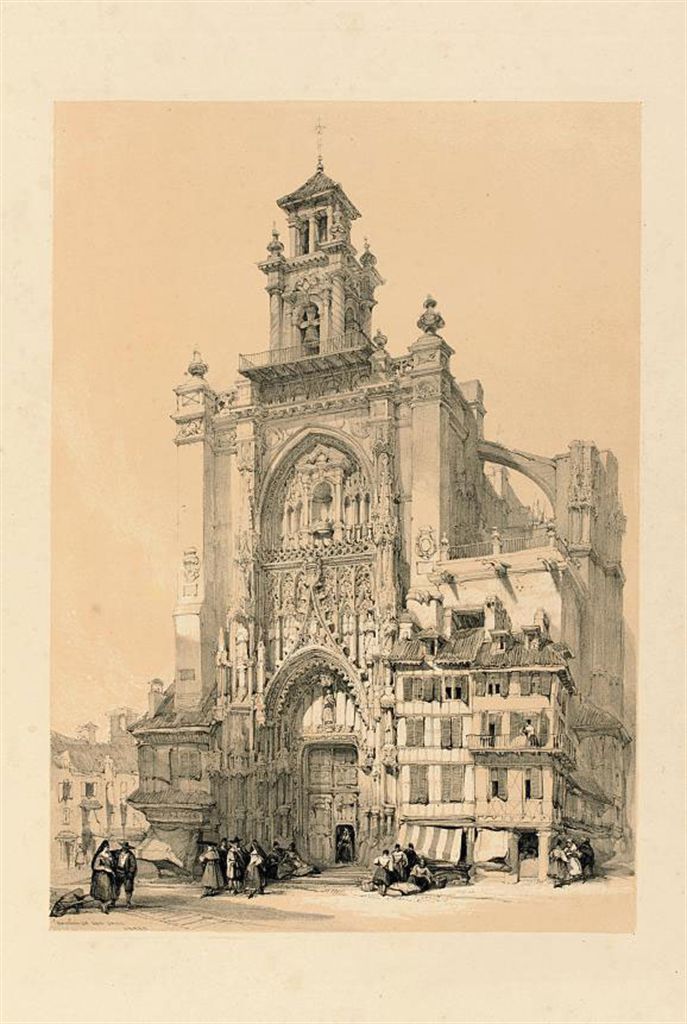Roberts' Sketches in Egypt and Nubia ... with Historical Descriptions by William Brockendon. London: F.G. Moon, 1846-9. 21 original parts in 13 (as issued). Folio (619 x 438 mm). 3 titles with lithographed vignettes and 121 tinted lithographed plates by Louis Haghe after drawings by Roberts, and two untinted maps, some plates out of order. Light foxing affecting a small number of plates, otherwise a very fresh and clean copy. Original publisher's printed wrappers contained in contemporary(?) wooden box with title; some light wear and chipping to edges. FIRST EDITION, IN RARE ORIGINAL PUBLISHER'S WRAPPERS. Considered "the most ambitious and impressive of English books illustrated with lithographs" (Ray), this set transports the viewer to exotic Egypt and Nubia through the eyes of prolific Orientalist painter David Roberts After moving to London in the 1820s to continue his career in theatrical scene-painting, Roberts began to exhibit his fine art paintings to critical accord and joined the Royal Academy in 1841. He embarked on a tour of the Middle East in 1838, returning home with numerous sketches from his adventure. Belgian engraver Louis Haghe produced a total of 248 lithographs based on Roberts' series of watercolors (after the sketches), which were originally published in monthly parts forming two commercially successful series: The Holy Land (1842-5) and Egypt and Nubia (1846-9). "Roberts's Holy Land was of the most important and elaborate ventures of nineteenth-century publishing, and it was the apotheosis of the tinted lithograph ... there is pleasure to be had from many of the individual plates, where Haghe's skillful and delicate lithography, and his faithful interpretation of Robert's draughtsmanship and dramatic sense, combine in what are undoubtedly remarkable examples of tinted lithographic work" (Abbey). Roberts' attention to detail and texture, as well as his ability to evoke a sense of the epic or nostalgic must surely be attributed to his early jobs painting trompe l'oeil stonework and paneling and as a scenic painter for the theater. Even Ruskin praised his "absolutely careful and faithful" panoramas (Abbey). From the daily lives of modern Egyptians attending mosque prayers and shopping at the bazaar to glorious ancient ruins rising from desert sands, Roberts' emotive landscapes captured the hearts and imaginations of the British public. Abbey Travel 244-341; Ray 88; Tooley 402.
Roberts' Sketches in Egypt and Nubia ... with Historical Descriptions by William Brockendon. London: F.G. Moon, 1846-9. 21 original parts in 13 (as issued). Folio (619 x 438 mm). 3 titles with lithographed vignettes and 121 tinted lithographed plates by Louis Haghe after drawings by Roberts, and two untinted maps, some plates out of order. Light foxing affecting a small number of plates, otherwise a very fresh and clean copy. Original publisher's printed wrappers contained in contemporary(?) wooden box with title; some light wear and chipping to edges. FIRST EDITION, IN RARE ORIGINAL PUBLISHER'S WRAPPERS. Considered "the most ambitious and impressive of English books illustrated with lithographs" (Ray), this set transports the viewer to exotic Egypt and Nubia through the eyes of prolific Orientalist painter David Roberts After moving to London in the 1820s to continue his career in theatrical scene-painting, Roberts began to exhibit his fine art paintings to critical accord and joined the Royal Academy in 1841. He embarked on a tour of the Middle East in 1838, returning home with numerous sketches from his adventure. Belgian engraver Louis Haghe produced a total of 248 lithographs based on Roberts' series of watercolors (after the sketches), which were originally published in monthly parts forming two commercially successful series: The Holy Land (1842-5) and Egypt and Nubia (1846-9). "Roberts's Holy Land was of the most important and elaborate ventures of nineteenth-century publishing, and it was the apotheosis of the tinted lithograph ... there is pleasure to be had from many of the individual plates, where Haghe's skillful and delicate lithography, and his faithful interpretation of Robert's draughtsmanship and dramatic sense, combine in what are undoubtedly remarkable examples of tinted lithographic work" (Abbey). Roberts' attention to detail and texture, as well as his ability to evoke a sense of the epic or nostalgic must surely be attributed to his early jobs painting trompe l'oeil stonework and paneling and as a scenic painter for the theater. Even Ruskin praised his "absolutely careful and faithful" panoramas (Abbey). From the daily lives of modern Egyptians attending mosque prayers and shopping at the bazaar to glorious ancient ruins rising from desert sands, Roberts' emotive landscapes captured the hearts and imaginations of the British public. Abbey Travel 244-341; Ray 88; Tooley 402.



.jpg)











Try LotSearch and its premium features for 7 days - without any costs!
Be notified automatically about new items in upcoming auctions.
Create an alert